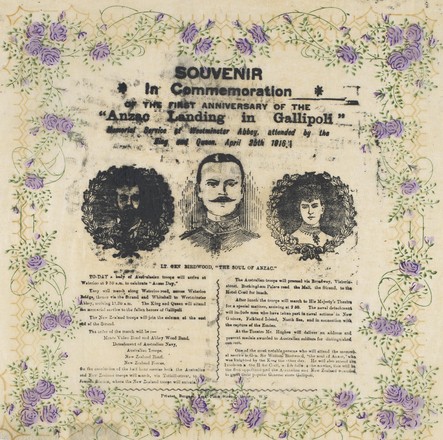This fragile printed souvenir was
published in London to mark the one-year commemoration of the ANZAC landing at
Gallipoli. Australians and New Zealanders were raucously welcomed by Londoners
and were feted as brave and handsome heroes. The events of the day were
reported in a number of British and Australian newspapers and the sentiments
expressed about the men who landed at ANZAC Cove one year prior, perhaps
perpetuated some of the myths which can still surround the landings at
Gallipoli one hundred years on.
A memorial service was held in
London on the first anniversary of the landing at Gallipoli. This service was
held at Westminster Abbey and the King and Queen were in attendance, along with
General Sir William Birdwood who had recently been knighted for his service at
Gallipoli. According to The Times,
the streets outside the Abbey were ‘thronged by thousands on thousands to whom
the appeal of the remembered deeds of April 25, 1915, were irresistible.’ Those
who received the most attention were the wounded who had been transported from
their hospitals for the day. It was reported that these men were;
‘attended by nurses in grey cloaks
with red collars. Many of the soldiers appeared to have almost completely
recovered from their wounds. Some, who had lost a leg, came in on crutches;
others limped in on sticks. They all looked cheerful and hearty.’
There were also a group of blinded
men who attended the service who, ‘bore themselves proudly’. There were over
100 severely wounded men who attended, including one New Zealander, Trooper
Geange of the 6th Wellington Mounted Battalion who was lying on pillows in an
invalid carriage with a shattered spine. He attracted the King's notice after
the service and he shook hands with Trooper Geange and spoke a few words of
sympathy with him.
It was reported that just after
10am, a thousand of the Australian troops came swinging over Waterloo Bridge in
columns of four towards Westminster Abbey;
‘Fine strong men they were, with
bronzed faces. They marched casually but not carelessly, and their body
movements suggested above all else health and strength. A great shout of welcome
met them as they turned into the Strand…Mingled with the shrill hurrahs of the
women and the hoarser greetings of the men came echoing calls of “Coo-ee”.
After a few minutes Britishers too tried to give the call, but with only
partial success, and most of them came back to the national “hurrah”.’
After the service, more than 2,000
Australian and New Zealand troops marched through the streets of the capital to
a rapturous reception from the crowds. It was reported that there were no
‘trappings of military pomp, except the music of martial bands. They carried no
rifles; they marched on foot, only the bare khaki of their uniforms showed them
for what they were – veterans of the Gallipoli landing, come from Australia and
from New Zealand to fight for Great Britain.’
It was reported in Australian newspapers that there was
dissatisfaction amongst Australian troops as to who were included in the march.
The men of the Light Horse had been chosen to head the procession, while the
men of the 3rd, 2nd and 1st Brigades, who were in the original landing, were in
the rear of the procession. The newspapers reported that ‘there were many
heart-burnings, it is alleged, because the smaller men were not selected, but
had to remain in the camps, while the "giants" were included in the
procession - some, of whom had never seen the Gallipoli Peninsula.’
After the march, the troops were
served lunch at the Hotel Cecil where Australian Prime Minister Billy Hughes
gave a speech praising the bravery and tenacity of the men who landed at
Gallipoli one year prior. Hughes’ language of high patriotism helped cement the
mythology around the ANZAC landing;
‘Soldiers, your deeds have won you
a place in the Temple of the Immortals. The world has hailed you as heroes.
Your comrades of the British Army claim you as brothers in arms, and the
citizens of the Empire are proud to call you kinsmen … You have covered
yourselves with the glory that does not fade, your names will be handed down in
your own native land and become household words.’
After the lunch, the troops
attended His Majesty’s Theatre for a matinee performance.
Early on in the war, Australian
troops were greeted enthusiastically by Londoners, as evidenced by the 1916
memorial service and march. The ANZACs had made a name for themselves at
Gallipoli and their distinctive uniforms, their happy, charming demeanour and
the fact they were the best paid troops in the Empire, meant they were very
popular in London, particularly with women. By the conclusion of the war, the
relationship had become strained. Instances of bad behaviour were reported in
British newspapers and in some quarters, Australian soldiers had gained a bad
reputation. Likewise, Australian servicemen and women were eager to return home
to Australia, having had their fill of cold climates and some five years of
grinding war.
Elise Edmonds, Senior Curator,
Research & Discovery
References:
The ANZAC tradition: early
commemorations, Australian War Memorial website, https://www.awm.gov.au/commemoration/anzac/anzac-tradition/, accessed 5 Feb. 2016.
Public Tribute To Anzacs." Times
[London, England] 24 Apr. 1916: 6. The Times Digital Archive. Web. 3
Feb. 2016.
"In Honour Of Anzac." Times
[London, England] 26 Apr. 1916: 2. The Times Digital Archive. Web. 3
Feb. 2016.
"Mr.Hughes On Empire." Times
[London, England] 26 Apr. 1916: 2. The Times Digital Archive. Web. 3
Feb. 2016.
ANZAC DAY. (1916, April 27).
Barrier Miner (Broken Hill, NSW : 1888 - 1954), p. 4. Retrieved February
5, 2016
ANZAC DAY. (1916, April 27).
The Sydney Morning Herald (NSW : 1842 - 1954), p. 9.



 Back to list
Back to list